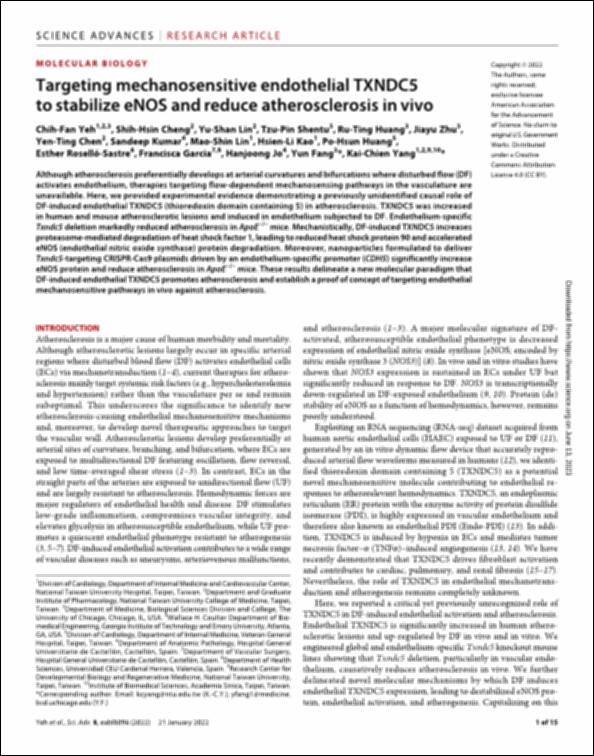Please use this identifier to cite or link to this item:
http://hdl.handle.net/10637/14444Targeting mechanosensitive endothelial TXNDC5 to stabilize eNOS and reduce atherosclerosis in vivo
| Title: | Targeting mechanosensitive endothelial TXNDC5 to stabilize eNOS and reduce atherosclerosis in vivo |
| Authors : | Yeh, Chih-Fan Cheng, Shih-Hsin Lin, Yu-Shan Shentu, Tzu-Pin Huang, Ru-Ting Zhu, Jiayu García Fernández, Francisca |
| Keywords: | Atherosclerosis.; Ateroesclerosis.; Molecular biology.; Proteínas.; Proteins.; Biología molecular. |
| Publisher: | American Association for the Advancement of Science |
| Citation: | Yeh, C. F., Cheng, S. H., Lin, Y. S., Shentu, T. P., Huang, R. T., Zhu, J., Chen, Y. T., Kumar, S., Lin, M. S., Kao, H. L., Huang, P. H., Roselló-Sastre, E., Garcia, F., Jo, H., Fang, Y. & Yang, K. C. (2022). Targeting mechanosensitive endothelial TXNDC5 to stabilize eNOS and reduce atherosclerosis in vivo. Science Advances, vol. 8, i. 3 (21 jan.), art. eabl8096. DOI: https://doi.org/10.1126/sciadv.abl8096 |
| Abstract: | Although atherosclerosis preferentially develops at arterial curvatures and bifurcations where disturbed flow (DF) activates endothelium, therapies targeting flow-dependent mechanosensing pathways in the vasculature are unavailable. Here, we provided experimental evidence demonstrating a previously unidentified causal role of DF-induced endothelial TXNDC5 (thioredoxin domain containing 5) in atherosclerosis. TXNDC5 was increased in human and mouse atherosclerotic lesions and induced in endothelium subjected to DF. Endothelium-specific Txndc5 deletion markedly reduced atherosclerosis in ApoE−/− mice. Mechanistically, DF-induced TXNDC5 increases proteasome-mediated degradation of heat shock factor 1, leading to reduced heat shock protein 90 and accelerated eNOS (endothelial nitric oxide synthase) protein degradation. Moreover, nanoparticles formulated to deliver Txndc5-targeting CRISPR-Cas9 plasmids driven by an endothelium-specific promoter (CDH5) significantly increase eNOS protein and reduce atherosclerosis in ApoE−/− mice. These results delineate a new molecular paradigm that DF-induced endothelial TXNDC5 promotes atherosclerosis and establish a proof of concept of targeting endothelial mechanosensitive pathways in vivo against atherosclerosis. |
| Description: | Esta comunicación se encuentra disponible en la siguiente URL: https://www.science.org/doi/epdf/10.1126/sciadv.abl8096 En este artículo de investigación también participan: Yen-Ting Chen, Sandeep Kumar, Mao-Shin Lin, Hsien-Li Kao, Po-Hsun Huang, Esther Roselló-Sastre, Hanjoong Jo, Yun Fang y Kai-Chien Yang. |
| URI: | http://hdl.handle.net/10637/14444 |
| Rights : | http://creativecommons.org/licenses/by/4.0/deed.es |
| ISSN: | 2375-2548 (Electrónico) |
| Language: | es |
| Issue Date: | 21-Jan-2022 |
| Center : | Universidad Cardenal Herrera-CEU |
| Appears in Collections: | Dpto. Medicina y Cirugía |
Items in DSpace are protected by copyright, with all rights reserved, unless otherwise indicated.


